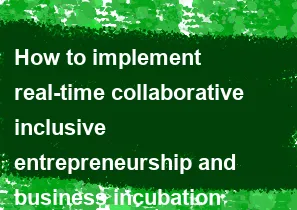How to implement real-time collaborative inclusive entrepreneurship and business incubation platform in AngularJS

Creating a real-time collaborative inclusive entrepreneurship and business incubation platform in AngularJS involves several steps. Below, I'll outline a basic approach to get you started:
Project Setup: Set up a new AngularJS project. You can use Angular CLI or set it up manually. Make sure you have Node.js and npm installed.
Authentication and User Management: Implement authentication and user management system. You can use libraries like Firebase Authentication or implement your own authentication system with JWT (JSON Web Tokens).
Real-Time Communication: For real-time communication, you can use WebSockets or a library like Socket.io. This will allow users to collaborate in real-time. You'll need a backend server to handle WebSocket connections.
Database Integration: Choose a database to store your data. Firebase Realtime Database or Firestore are options that work well with AngularJS. If you prefer a traditional database, you can set up a backend server with a database like MongoDB or PostgreSQL.
Collaborative Document Editing: Implement collaborative document editing using libraries like Quill.js or ProseMirror. These libraries provide collaboration features out of the box.
Business Incubation Features: Implement features for business incubation such as project management, mentorship matching, resource sharing, etc. You'll need to design the database schema and implement the frontend and backend logic for these features.
Accessibility: Ensure that your platform is accessible to users with disabilities. Follow accessibility best practices and use tools like Angular Accessibility Plugin to check for accessibility issues.
Testing and Deployment: Write unit tests and end-to-end tests for your application using tools like Karma and Protractor. Once testing is complete, deploy your application to a hosting provider like Firebase Hosting or Heroku.
Continuous Integration and Continuous Deployment (CI/CD): Set up CI/CD pipelines to automate the testing and deployment process. Tools like GitHub Actions or Jenkins can be used for this purpose.
Feedback and Iteration: Gather feedback from users and iterate on your platform based on their feedback. Continuously improve the user experience and add new features as needed.
Remember that building such a platform is a complex task that requires careful planning and execution. Make sure to break down the project into smaller tasks and tackle them one at a time. Additionally, leverage existing libraries and frameworks to speed up development and focus on delivering value to your users.
-
Popular Post
- How to optimize for Google's About This Result feature for local businesses
- How to implement multi-language support in an Express.js application
- How to handle and optimize for changes in mobile search behavior
- How to handle CORS in a Node.js application
- How to use Vue.js with a UI framework (e.g., Vuetify, Element UI)
- How to configure Laravel Telescope for monitoring and profiling API requests
- How to create a command-line tool using the Commander.js library in Node.js
- How to implement code splitting in a React.js application
- How to use the AWS SDK for Node.js to interact with various AWS services
- How to use the Node.js Stream API for efficient data processing
- How to implement a cookie parser middleware in Node.js
- How to implement WebSockets for real-time communication in React
-
Latest Post
- How to implement a dynamic form with dynamic field styling based on user input in Next.js
- How to create a custom hook for handling user interactions with the browser's device motion in Next.js
- How to create a custom hook for handling user interactions with the browser's battery status in Next.js
- How to implement a dynamic form with dynamic field visibility based on user input in Next.js
- How to implement a dynamic form with real-time collaboration features in Next.js
- How to create a custom hook for handling user interactions with the browser's media devices in Next.js
- How to use the useSWRInfinite hook for paginating data with a custom loading indicator in Next.js
- How to create a custom hook for handling user interactions with the browser's network status in Next.js
- How to create a custom hook for handling user interactions with the browser's location in Next.js
- How to implement a dynamic form with multi-language support in Next.js
- How to create a custom hook for handling user interactions with the browser's ambient light sensor in Next.js
- How to use the useHover hook for creating interactive image zoom effects in Next.js